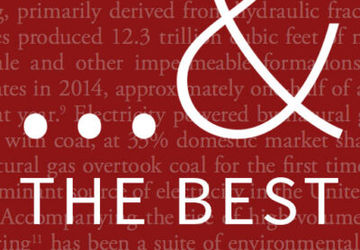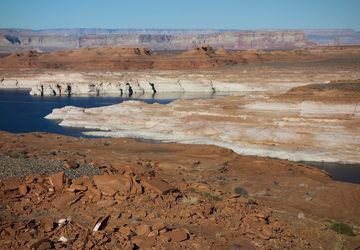A sneak peak at "West x Southwest: Edward Weston and Ansel Adams"

Ansel Adams (U.S.A., 1902–1984), Moonrise, Hernandez, New Mexico, c.1941. Gelatin silver print. Used with permission of and © The Ansel Adams Publishing Rights Trust. The Capital Group Foundation Photography Collection at Stanford University, 2019.42.37
What is the American West? Students and scholars at the Bill Lane Center think about this question all the time. One way to answer it is to spend some time in the presence of photographs so masterful in their rendering of “place,” they have come to define the American Western region in popular imagination. On Thursday, November 7, the Bill Lane Center hosted a curatorial tour of the Cantor Arts Center’s photography exhibition, “West x Southwest: Edward Weston and Ansel Adams," led by Elizabeth Mitchell, the Burton and Deedee McMurtry Curator and director of the Curatorial Fellowship Program at Cantor. On display were images shot by the photographers at moments and in places where their careers as artists crystallized. According to Mitchell, scholars looking back on Weston’s career see him as coming into his own as a photographer while in Mexico. For Ansel Adams, it was the American Southwest that inspired so much of his work. Experiencing this exhibition, then, is very much an education in place, with landscapes, still lifes, nudes and portraits telling the story of a region as seen through the eyes of celebrated American photographers. A public tour of "West x Southwest" is scheduled for Sunday, January 5 from 12:30 p.m. - 1:30 p.m. at the Cantor Arts Center. All are welcome.
Before the tour on November 7, Alexandra (Mac) Taylor, ’20, a student research associate for the Bill Lane Center’s ArtsWest initiative, sat down with exhibition curator Elizabeth Mitchell to learn more about the photographs and Mitchell’s vision for engaging audiences with the work. The interview has been condensed and edited for clarity.
AT: The Cantor Arts Center was given over 1,000 photographs as a gift from the Capital Group Foundation. This exhibit showcases only some of them. Given the breadth of work you had to choose from, what factors influenced your decision-making in terms of what pieces are on display and how you’ve chosen to present them?
EM: We were given roughly 1,086 photographs, I believe. I was charged with creating three initial exhibitions to advertise this gift to the world, and each exhibit will contain only 40 or 50 prints. So, in total, I'm only going to be showing 150 prints out of this gift of over 1,000. I'm just scratching the surface of this amazing treasure. Many projects will come after it that will explore the work in different ways.
In selecting photographs for “West x Southwest,” I wanted to find a theme that was of interest to me, that hadn’t already been thoroughly researched by scholars. In Northern California, there's no better way to announce there's something great happening at a museum than to include Ansel Adams and Edward Weston. So, it seemed pretty logical that they would provide a great platform for us to kick off this suite of exhibitions. That was the rationale behind working with them. I also wanted to introduce the public to the Capital Group Foundation photos in a way that showed the teaching potential, but also showcased some of the really fine prints in the collection. I just took a tiny slice in order to announce it to the world.
AT: Can you talk a bit more about the origin of this collection as a gift, and how it came to be at the Cantor Arts Center?
EM: Yes. The Cantor has been working with the Capital Group Foundation for nearly 20-25 years, while they acquired photo archives by certain artists and we used them at the museum as long-term loans. Some of the Foundation’s archives would come here, to Stanford, and some were housed elsewhere. We were allowed to use the photographs for exhibitions and for teaching in the context of this lovely partnership: we would maintain, store, and show the photographs here at Stanford, but the Foundation owned the archives. Over time, they decided that they really wanted the collection to go to one place, and they ultimately selected the Cantor Arts Center to be the permanent home for the collection.
AT: You mentioned this collection of work includes many prominent photographers who have arguably defined the public's image of the American West, and of California in particular. Do you think the show highlights the power of these artists as shapers of an American imagination or an American conception of the West? If so, in what ways?
EM: Yes. Rather than mount a conventional “greatest hits” show of Ansel Adams and Edward Weston, I decided to look at very early work that they created in places and at moments where they really became photographers. Scholars look back on these moments where the photographers’ careers took shape, and they see Weston in Mexico. This is where his vision gelled. With Ansel Adams, his relationship with the Southwest so infused everything he did afterwards…It’s kind of interesting to take these photographers out of the California context and think about their early careers.
AT: Curating any show is a highly intentional act from start to finish. With this show in particular, what led you to design the exhibit as you did in terms of entry through finish?
EM: When you enter you see a comparison between the two artists. Right away I wanted to invite you to recognize these photographers, and the fact that we’re familiar with their work as mature artists. I tried to select prints that were not that obvious, but that spoke to each other. This exhibition traces where the photographers came from. It was just a matter of illustrating early work by Weston that gives a sense of his formal goals. I introduced some early works by Adams to compare against Weston’s, and then the rest of the gallery is a conversation between the two. There's a wall of Weston’s projects that faces a wall of Adams’ projects, and you can look back and forth and see how Adams was working on the macro-level and Weston was honing his vision on a micro-level. There's also a wall where their works are mixed together. The hope here is that after you've walked around and looked at some of the photographs, and you’ve developed a comfort level thinking “Oh well, yes, that's Weston because of X,” and “That must be Adams because of Y,” there's a wall where they're mixed together that might challenge you. You might walk up to something and think, “Oh, that has to be Weston,” but then realize “Oh my goodness, that's Adams.” It's all about showing that the two photographers were on different wavelengths, but also working so closely in many ways. They have a fascinating relationship.
AT: Thinking about the visual dialogue that you’ve created, do you have a specific image that you’d identify as a favorite?
EM: There are about 39 favorites in the gallery. There is a stunning nude by Edward Weston taken in 1925. It's just titled “Nude,” and it's a portrait of Anita Brenner in which he threw away all the rules of portraiture. We're just seeing an image of her back, and her head has been cropped out. Her arms are pulled forward, so it really is just the shape of her back. To him, this was his way of accessing who she was, essentially. He did not need to show her face, her environment, or her clothing to tell a story about who she was. He just found the essential form, which is a very powerful act. That is just one of many photographs that I think is truly extraordinary.
AT: Absolutely, and I'm sure the show is full of images that are quite striking and powerful for the viewer. Thinking about this, is there one particular emotion or feeling you think audiences might experience while actively looking at the photos, or after leaving the exhibit? Or is there a particular emotion you feel yourself?
EM: For me, as an art historian, it was just exciting to be able to work with these particular objects and to put them together in a gallery. I do not prescribe or expect anybody to come out feeling one particular thing. When you design an exhibition you understand that it has to work a bit like an essay: it has an introduction, a narrative build-up, and a conclusion. But you can't assume that people look at every object, or read every label, or read any labels. It has to hang together visually, but it also has to have a clear story. Knowing that people experience exhibitions in such a complex way, I do not try to project anything onto people because they take away what they want.
AT: In closing, you mentioned that there are two future exhibits planned for the Capital Group Foundation photographs. What are the museum's plans for the next installment of images from this collection?
EM: The next exhibition is called “Outside Looking In,” and it features the works of Helen Levitt, John Gutmann, and Wright Morris – all photographers who were very active in the 1930s and 1940s, though they had longer careers. Most of what we'll be looking at will be from the 1930s and 1940s. Each of these artists uses the camera to look in on another group, or another environment, to understand and interpret American society in different ways. Morris was looking at the history of his own family in Nebraska. Gutmann had moved here to San Francisco from Germany right between the wars, so he was encountering American culture afresh. As a result, his street photographs are very, very interesting. Levitt was born in Brooklyn, but she would walk around Spanish Harlem or other neighborhoods and just photograph people on the street – kids playing, all the little dramas that evolve on streets and stoops. So, again, they are using the camera to understand others as an interpretive tool.
The final exhibition is called “A Loaded Camera: Gordon Parks,” and it focuses exclusively on the work of Gordon Parks, his artistic and creative work, as well as his photojournalism.
Audiences are welcome to join the Bill Lane Center's next public tour of "West x Southwest" on Sunday, January 5 from 12:30 p.m. - 1:30 p.m. at the Cantor Arts Center.


